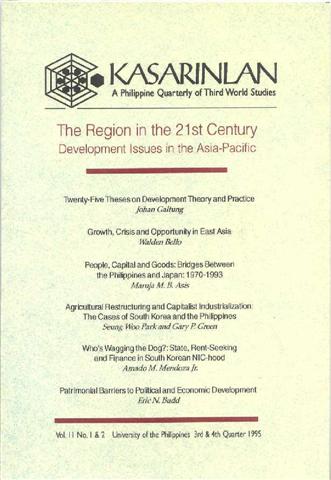Growth, Crisis and Opportunity in East Asia
Abstract
The Asia-Pacific region is seen by western governments and business crises as the fulcrum of the world economy in the 21st century. The image of prosperity in the region, however, masks a process of growth that is marketed by high ecological costs, a widening gap between agriculture and industry, and increasing inequality in income distribution. Moreover, conflicts are developing between Asian and non-Asian governments and economic elites for the domination of its vast market. Rapid growth is, in turn, leading not to peace among countries but to growing tensions, if not outright conflicts, in what has become the fastest market for conventional arms. Growth has also been accompanied by growing antagonisms within countries where rapid economic growth has taken place largely within authoritarian or restricted political systems. Farming populations, which have to be marginalized by the growth process, join the urban masses created by it to demand more democratic systems of rule.Central to the future of peace and security in East Asia is the spread of democracy. In contrast to authoritarian governments, democratic governments, seldom go to war with one another. The primary reason for this is the presence in democratic governments of mechanisms like checks and balances, the free press and public opinion. This democracy is therefore different from the “Asian democracy” propagated by Asian elites; the latter for formulation is in reality, authoritarianism in the guise of democracy. The emergence of the thesis that there is a mode of governance peculiar to Asians in recent ideological debates is counteroffensive employed by alarmed elites against the democratic wave that has been sweeping Asia since 1986.
Moreover, amid the realities currently besieging East Asia, the alternative paradigm for change espoused by the progressives becomes more relevant than ever. The paradigm articulates: (1) the need to formulate a model for sustainable development appropriate for East Asia; (2) the need for Cold War multilateral system of peace and security; and (3) the need to build a regional democratic movement that will assist those still living under authoritarian rule to make the transition to democratic rule.
How to Cite
BELLO, Walden.
Growth, Crisis and Opportunity in East Asia.
Kasarinlan: Philippine Journal of Third World Studies, [S.l.], v. 11, n. 1, june 2007.
ISSN 2012-080X.
Available at: <https://journals.upd.edu.ph/index.php/kasarinlan/article/view/1625>. Date accessed: 23 aug. 2025.
Section
Features
Keywords
Asia-Pacific, East Asia, World Economy
By submitting a manuscript, the authors agree that the exclusive rights to reproduce and distribute the article have been given to the Third World Studies Center.



